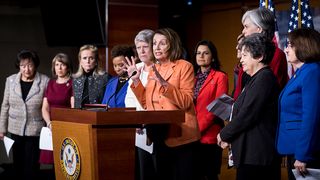Prompted by the results of elections of that year, US media heralded 1992 as the Year of the Woman. With 24 females elected to the House of Representatives, and three to the Senate, a record number of candidates had been successful in almost doubling female representation in Congress. The previous year, Anita Hill had detailed in front of an all-male Senate Judiciary Committee the alleged unwanted advances made towards her by US Supreme Court nominee Clarence Thomas. The televised confirmation hearings sparked a national conversation about sexual harassment in the workplace, and invigorated women to fight for a greater say in the political process.
In the current context of #MeToo, Women’s Marches around the country, and continued debates over inadequate sexual harassment policies in workplaces, the conversations of 1992 have retained much of their relevance. Today, US news outlets are again reporting a surge in the number of women running for political office. The largest increase has been seen in the House of Representatives, with 354 women running in total – 291 Democrats and 63 Republicans. The number of women challenging incumbents is almost four times the number at the same period in 2015.
Partisan and non-partisan organisations devoted to promoting women to elected office, such as Emily’s List and She Should Run, have reported overwhelming levels of interest in their advocacy services and have subsequently launched new campaigns capitalising on this momentum. In November, all seats in the House of Representatives, a third of the Senate, as well as most governorships and hundreds of seats in state legislatures will be decided. Following the encouraging signs of 2017, such as Danica Roem’s historic election to the Virginia House of Delegates, women have now set their sights on this year’s midterm elections. Their campaigns are being bolstered by increased levels of fundraising, as well as targeted efforts by both parties to increase the number of female candidates and offset the loss of women already in office who will not be seeking re-election.
Despite the growing enthusiasm around the United States, a few caveats to this emergent “pink wave” narrative must be noted: higher numbers of men are also running this year, meaning that women will still make up less than a quarter of likely congressional candidates overall. Further, while a rash of retirements in the House of Representatives will potentially mitigate the structural disadvantage women face from incumbency, many are still seen as long-shots in their respective races.
The fight for equal political participation has been a long and challenging road for women in the United States, as in many other countries throughout the world. Twenty-six years on from the Year of the Woman, they remain conspicuously under-represented in political office, holding less than 20 per cent of the 535 seats in the 115th US Congress. On Election Tuesday this year, let’s hope that statistic can be changed for the better.






